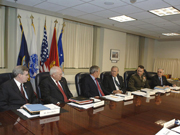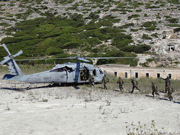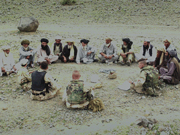

Current US Security Strategy
What is the current US National Security Strategy? The National Security Strategy (NSS), released in 2006, is best understood as an update of the NSS released right after the terrorist attack on the US on September 11, 2001. Both of these strategies make a very important assumption about the international security environment and the role of the US within it. That assumption is stated directly in the first sentence of the letter from President Bush introducing the 2006 NSS: "America is at war. This is a wartime national security strategy." 3 That language is not found in any version of the NSS before 2002.
With whom—or what—is the US at war? The answer, according to the NSS, is "terrorism fueled by an aggressive ideology of hatred and murder." 4 The US, the strategy argues, "is in the early years of a long struggle, similar to what our country faced in the early years of the Cold War." 5 A key difference between this new conflict and the Cold War concerns the nature of the ideology that drives the enemy. The roots of this new ideology lie "in the perversion of a proud religion." 6 "Transnational terrorists . . . exploit the proud religion of Islam to serve a violent political vision: The establishment, by terrorism and subversion, of a totalitarian empire that denies all political and religious freedom." 7
If the US is at war with a global terrorism based upon this violent political vision, what strategy does it propose to fight this war? The answer has several layers. The first layer is to "create a world of democratic, well-governed states." 8 According to the NSS, "the fundamental character of regimes matters as much as the distribution of power among them." 9 The NSS argues that democracy is the best antidote for terrorism, hence "promoting democracy is the most effective long-term measure for strengthening international stability; reducing regional conflicts; countering terrorism and terror-supporting extremism; and extending peace and prosperity." 10
There are other layers to the war on terrorism revealed in the NSS. These include such things as strengthening alliances, preventing the spread of weapons of mass destruction (WMD), promoting economic development and transforming US national security institutions.
The "war on terror" outlined in the NSS involves conflict of several kinds and on many fronts. There is a distinctly military dimension, involving the use of "military force and other instruments of national power to kill or capture the terrorists, deny them safe haven or control of any nation; prevent them from gaining access to WMD; and cut off their sources of support." 11 The NSS concludes that in the long run, "winning the war on terror means winning the battle of ideas." 12
Weapons of mass destruction are singled out in the NSS as presenting a special, indeed a new kind of threat to US security. "The security environment confronting the United States today," it says, "is radically different from what we have faced before." 13 While WMD have been part of the international security environment for decades, the new threat they pose to the US is the possibility that terrorists will gain access to them. According to the NSS, "there are few greater threats than a terrorist attack with WMD." 14
The NSS argues that deterrence as practiced during the Cold War will not work against the new primary threat to American security. (Deterrence means having enough military capability that an enemy will not find it in his interest to attack under any circumstances.) During the Cold War, the adversary (the Warsaw Pact) was "a generally status quo, risk-averse adversary," 15 which meant that deterrence was effective. Today, however, "our enemies see weapons of mass destruction as weapons of choice." 16 That means that "traditional concepts of deterrence will not work." 17
The preemption doctrine
That prospect is the explanation for what may be the most controversial part of the NSS of 2006, first introduced in the post-9/11 NSS issued in 2002. I refer here to the "preemption doctrine." That doctrine is repeated in the 2006 NSS. Referring to the possibility of a terrorist attack using WMD, it states: "Under long-standing principles of self defense, we do not rule out the use of force before attacks occur, even if uncertainty remains as to the time and place of the enemy´s attack. When the consequences of an attack with WMD are potentially so devastating, we cannot afford to stand idly by as grave dangers materialize. This is the principle and logic of preemption." 18
But there is more to the WMD problem than simply preemption. The NSS calls for "proactive counterproliferation efforts" and "improved protection" against the consequences of WMD use, for example. 19 Controlling fissile material is central to the nuclear proliferation problem. And deterrence remains a part of the NSS, though "tailored" to meet "both state and non-state threats," 20 and supported by a "new Triad" of nuclear and conventional defensive systems, active and passive defense and "a responsive infrastructure." 21
Strategic activism and moralism
The NSS addresses many other specific elements of national security, from globalization to global warming, and in many instances singles out specific countries for special comment, for example, Iran and North Korea. However, beyond these matters, it is important to note the "tone" of the NSS, its assumptions about security for America and the international security environment. US policy makers take a very activist approach to the security environment. They do not believe that if the US keeps a low profile in the world, all will be well for its citizens. There is also a distinctly moralistic view of world politics found within this NSS.
This activism and moralism can be seen in the letter President Bush sent with the NSS, which says that "our approach is idealistic about our national goals," and that the pillars of our NSS include "promoting freedom, justice, and human dignity." The NSS has as its ultimate goal "ending tyranny in our world." 23 The US, it declares, "must defend liberty and justice because these principles are right and true for all people everywhere." 24 The survival of liberty in the US, it notes, "increasingly depends on the success of liberty abroad." 25 An essential part of the NSS involves free and fair trade, because "greater economic freedom is ultimately inseparable from political liberty," 26 and "[e]conomic freedom is a moral imperative." 27 The NSS concludes with these observations: "The times require an ambitious national security strategy . . . America cannot know peace, security, and prosperity by retreating from the world." 28
Analysis #1
You have now learned something about the current US National Security Strategy. This document, like all such strategies, gives us a picture of the international security environment as seen by the US and what it proposes to do in response to that picture. Does the strategy you have chosen to compare with the US NSS see the international security environment in this same way? If not, what is the most important difference in perception? Does the strategy you have chosen indicate that the country involved is in a war with transnational terrorism? Does it rank the proliferation of WMD and the possibility of terrorists gaining access to them as the most important threat to its security? If not, what does it identify as the most important threat?
Back to top





